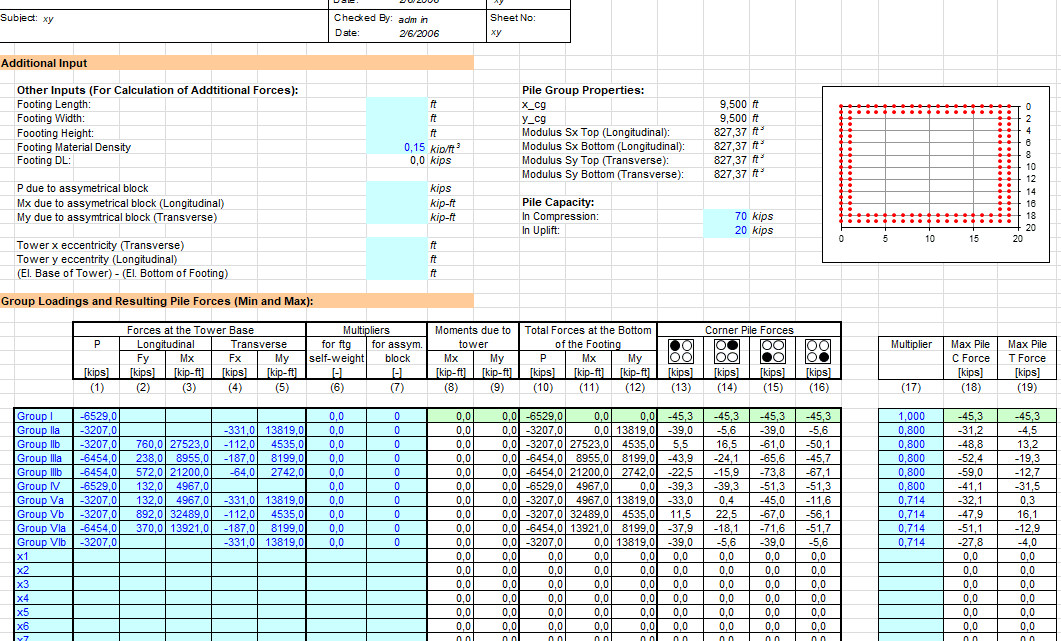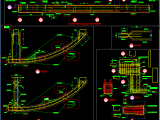
Pile Group Analysis Spreadsheet
19 July 2025Table of Contents
Pile Group Analysis Spreadsheet
In the world of construction, a solid foundation is non-negotiable. For large structures or sites with weak surface soils, deep foundations are essential to transfer building loads to stronger, more competent ground below.[1][2] While a single pile can support a significant load, the true strength for major projects lies in the collective power of a pile group. This sophisticated foundation system is more than just a collection of individual piles; it’s an integrated unit that offers enhanced stability, load capacity, and performance.
This article explores the concept of the pile group, its critical advantages over single pile foundations, and why it has become the preferred choice for everything from high-rise buildings to massive bridges.
What is a Pile Group?
A pile group consists of multiple individual piles installed relatively close to one another and connected at the top by a reinforced concrete pile cap.[3] This cap distributes the structural load from the columns and walls of a building evenly among the piles in the group.[4] The piles then act together as a single, cohesive unit to transfer these loads to the deep soil or rock layers.
The behavior of a pile group is fundamentally different from that of an isolated single pile. When piles are placed in a group, their zones of influence in the soil overlap, creating complex pile-soil-pile interactions.[3] This interaction is the key to both the group’s strength and the complexities of its design.
Single Pile vs. Pile Group: A Head-to-Head Comparison
While a single pile is a useful element, comparing it to a pile group reveals why “more is better” when it comes to foundational support for substantial structures.
Load Capacity and Distribution
-
Single Pile: The load-bearing capacity is limited to what one pile can handle through a combination of end-bearing (resting on a hard stratum) and skin friction (resistance along its shaft).[5]
-
Pile Group: A group of piles can support a much heavier load than the sum of the individual capacities of each pile might suggest.[6] The pile cap effectively distributes immense loads across all the piles, preventing any single element from being overloaded.[6] This is crucial for large-scale buildings and infrastructure that exert enormous pressure on their foundations.[2][6]
Settlement Control
-
Single Pile: While a single pile can limit settlement, its influence is localized.
-
Pile Group: A pile group is far more effective at controlling and minimizing settlement. By spreading the load over a much wider and deeper area, the pressure on the underlying soil is significantly reduced.[6] This mitigates the risk of differential settlement—where different parts of a structure sink at different rates—which can cause severe structural damage. The settlement of a pile group can, however, be greater than that of a single pile under the same individual load due to the overlapping zones of stress in the soil below the pile tips.[3][7]
Stability and Resistance to Lateral Loads
-
Single Pile: A single pile has limited resistance to lateral (horizontal) forces, such as those from wind, earthquakes, or earth pressure.[8]
-
Pile Group: The collective action of a pile group provides vastly superior stability against horizontal movements.[6] The group, acting as a unified block, can withstand significant lateral forces, ensuring the structure remains secure and stable.[6] Raker piles (installed at an angle) are often included in groups to further enhance resistance to these forces.[9]
Redundancy and Safety
-
Single Pile: If a single pile has an unknown defect or fails, it could have localized but significant consequences.
-
Pile Group: The use of multiple piles creates inherent redundancy.[6] If one pile in the group has a lower capacity or encounters an unforeseen issue, the load is redistributed to the neighboring piles. This provides an additional layer of safety and reliability, which is a requirement for most building codes.[3]
Understanding Pile Group Efficiency
A key concept in the design of these foundations is “pile group efficiency.” This is a measure of how the ultimate load capacity of the group compares to the sum of the ultimate capacities of each individual pile.[10] Mathematically, it’s the ratio of the group’s capacity to the sum of the individual pile capacities.[10][11]
Several factors influence this efficiency, including:
-
Pile Spacing: Piles spaced too closely can cause excessive overlap in their stress zones, reducing efficiency. A typical spacing is three to four times the pile diameter.[3][11]
-
Soil Type: In cohesive soils like clay, group efficiency can sometimes be less than 1 (meaning the group is less efficient than the sum of its parts) due to the way the piles and soil block fail together. In sandy soils, the compaction caused by driving piles can sometimes lead to an efficiency greater than 1.
-
Number of Piles: The more piles in a group, the more complex the interactions become, which can influence the overall efficiency.[12]
When Are Pile Groups Necessary?
Pile groups are the foundation of choice in a variety of challenging construction scenarios:
-
Supporting Heavy Structures: They are indispensable for high-rise buildings, bridges, water tanks, and industrial plants with heavy, concentrated loads.[13]
-
Weak or Compressible Soil: When the shallow soil layers are too weak to support a structure, pile groups transfer the load to deeper, more stable ground.[1][14]
-
Controlling Settlement: For structures that are sensitive to any movement or settlement, such as those housing precision instruments.[14]
-
Resisting Uplift and Horizontal Forces: In the construction of towers, offshore platforms, and retaining walls that must resist significant uplift or lateral loads.
In conclusion, while single piles are functional for smaller loads, the pile group stands as a far more robust, reliable, and stable solution for the demands of modern construction. By working together as an integrated system, a group of piles provides the superior strength, stability, and safety required to support the world’s most ambitious structures, ensuring they stand firm for decades to come.


